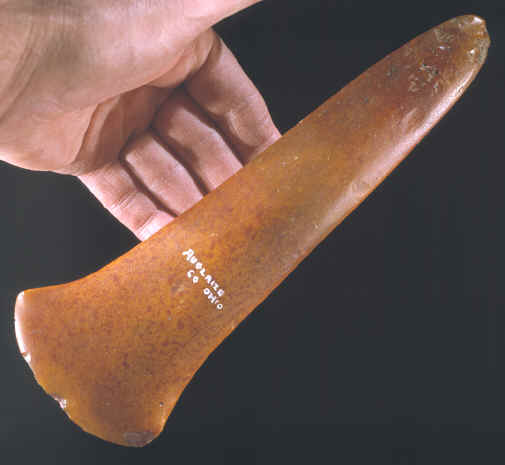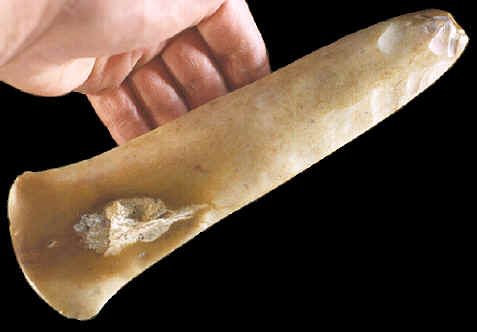|
|
|
Most of the spuds illustrated in this article, except for those in the Stevens collection picture, the Jersey Bluff spud and the long stemmed barbed spud pictured above were made from chert. Chert spuds were first flaked into shape then they were ground and polished. Spuds made of granite & other materials that do not flake well were made the same axes were made. By pecking them into shape with a hammer stone then finishing them into shape by grinding and polishing the surface. |
|
|
Stone spuds are represented by a wide range of shapes and sizes. It's obvious that the basic form, found at Cahokia, developed from ungrooved axes known as celts. Celts were utilitarian tools that were made in large numbers for cutting wood. |
|
|
|
|
Just as there were many different styles of spuds there were also many different styles of celts. The flared bit variety of celt seems to be the pattern from which the Cahokia style of spuds developed. In fact, some flared bit celts are the same size and shape as some spuds. The only difference between the two is the quality of stone and the degree of surface polish. B. W. Stevens writes in 1954 "It is obvious that the highly developed spatulate specimens are directly associated to the common forms of celts." |
|
|
|
|
We know that celts were hafted like axes because examples have been found with wooden handles still attached. There are pictographs on stone outcrops that show complete axes and stone carved monolithic axes that illustrate hafted axes in three dimensional sculptures. C. B. Moore also reported seeing "marks left by a handle" on at least two Class C spuds from Alabama. It's logical to assume that most spuds were probably hafted onto handles. At least one hafted spud is illustrated in a pictograph at Madden Creek in Washington County, Missouri. It shows a very elaborate handle. |
|
|
Spuds have been found in a wide range of sizes. One of the largest is known as the "Grove Spud. It was found by a farmer in 1963 near the Cahokia Mounds site. It's made of compact greenstone and measures 18 1/2 inches long. Moorehead illustrates a small spud measuring only 3 1/8 inches long and he quotes Brown-- "the largest known example measuring 22 3/4 inches in length." The larger examples are Class A spuds. The smallest example is a class B spud. |
|
| CONTINUE ON TO PAGE FOUR | |
|
"REFERENCES"
1910,
Moorehead, Warren K., "The Stone Age In North America," Vol. 1,
Chapter XXII, "Ground Stone---Problematical Forms, The Spud-Shaped
Implement," pp. 418-430. |
|




